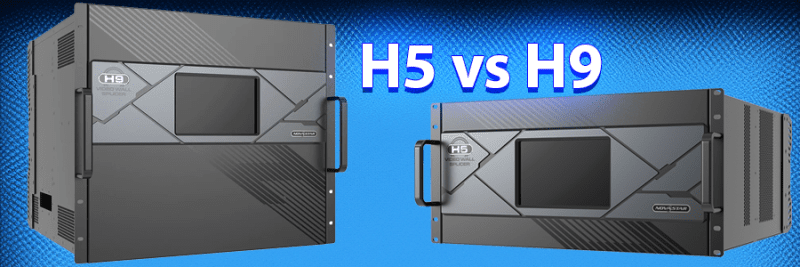NovaStar H5 and H9: The Right Video Splicing Processor for Your Project
Hampus Niskala |4/05, 2024

When it comes to selecting the right LED display controller for your needs, NovaStar offers a range of high-performance options. Two of the most popular choices are the H5 and H9 controllers. Both models are packed with advanced features, but they cater to slightly different requirements. In this article, we'll help you understand the key differences between the H5 and H9, so you can make an informed decision that best suits your specific needs.
Overview of H5 and H9
H5 Controller:
- Pixel Loading Capacity: Up to 13,000,000 pixels
- Input and Output: Supports multi-screen and multi-layer management, input and output EDID management, and monitoring.
- Architecture: B/S architecture, supporting cross-platform and cross-system access and control.
- Certifications: CE, UKCA, FCC, IC, UL, CB, NOM, RCM, KC, CMIM
- LED 4K Sending Cards: H_20xRJ45, H_16xRJ45+2xfiber, H_4xfiber sending cards
H9 Controller:
- Pixel Loading Capacity: Up to 20,800,000 pixels
- Input and Output: Similar to H5, with additional support for more advanced configurations.
- Architecture: B/S architecture, supporting cross-platform and cross-system access and control.
- Certifications: CE, UKCA, FCC, IC, UL, CB, RCM, KC, CMIM, CCC
- LED 4K Sending Cards: H_20xRJ45, H_16xRJ45+2xfiber, H_4xfiber sending cards
Key Differences
Pixel Loading Capacity:
- H5: The H5 can handle up to 13,000,000 pixels, making it suitable for medium to large-sized displays.
- H9: The H9 boasts a higher capacity of up to 20,800,000 pixels, ideal for ultra-large and high-resolution displays.
Certifications:
- H5: Certified with CE, UKCA, FCC, IC, UL, CB, NOM, RCM, KC, CMIM.
- H9: Includes all certifications of the H5, plus CCC, making it compliant with a broader range of international standards.
Advanced Features:
- H5: Supports essential features like multi-screen and multi-layer management, input source renaming, BKG and OSD settings, and online firmware updates.
- H9: Includes all features of the H5, with additional support for more advanced configurations and higher pixel capacities, making it more suitable for complex and large-scale installations.
Which One Should You Choose?
Choose the H5 if:
- You are managing medium to large-sized displays.
- Your pixel loading requirements are up to 13,000,000 pixels.
- You need a reliable and versatile controller with essential features for most standard applications.
- You prefer a more cost-effective solution without compromising on quality and performance.
Choose the H9 if:
- You are handling ultra-large and high-resolution displays.
- Your pixel loading requirements exceed 13,000,000 pixels, up to 20,800,000 pixels.
- You need advanced configuration options and higher capacity sending cards.
Conclusion
Both the H5 and H9 controllers from NovaStar are excellent choices, each offering unique benefits tailored to different needs. The H5 is perfect for medium to large-sized displays with standard requirements, while the H9 is designed for more complex and high-capacity installations. By understanding your specific needs and the key differences between these two models, you can make an informed decision that ensures optimal performance for your LED display projects.
For more information or to purchase the H5 or H9 controllers, visit our H-series category page or contact our support team at [email protected]. We're here to help you find the perfect solution for your LED display needs.

 Svenska
Svenska